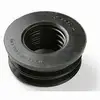The existing waste pipework from my bath and wash hand basin are all in solvent weld and need replacing. The bath is 40mm and the wash hand basin is 32mm. Both connect separately into the 110mm soil pipe via strap boss connectors. I would prefer to use push fit instead of solvent weld as I already have some 40mm and 32mm push fit fittings and pipe readily available.
If I leave the two solvent weld 90 degree bends in that are both cemented into the wall and chop the old solvent weld pipes leaving a couple of inches spare to connect the new onto, can I get a solvent weld to push fit straight coupler/adapter? Alternatively, would a compression coupler work connecting one side to my existing solvent weld pipe and the other side to my new push fit pipe?
If I leave the two solvent weld 90 degree bends in that are both cemented into the wall and chop the old solvent weld pipes leaving a couple of inches spare to connect the new onto, can I get a solvent weld to push fit straight coupler/adapter? Alternatively, would a compression coupler work connecting one side to my existing solvent weld pipe and the other side to my new push fit pipe?




